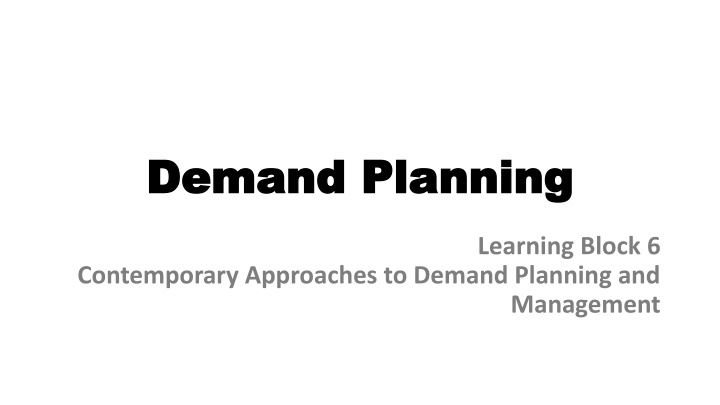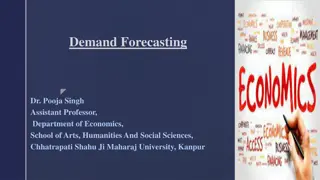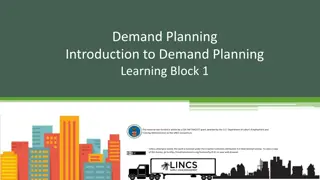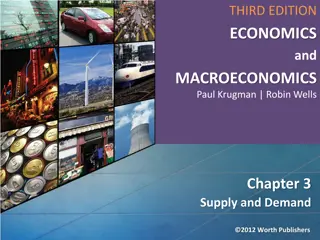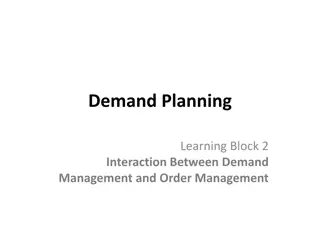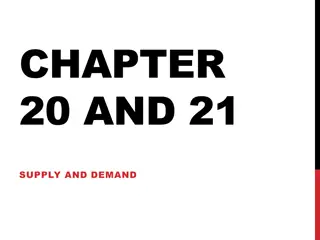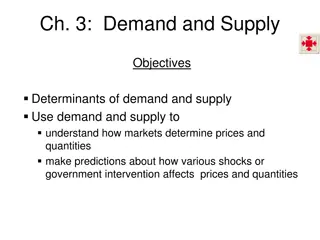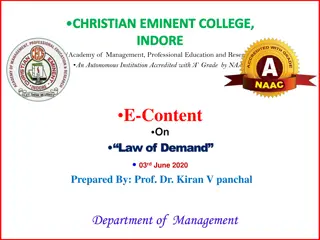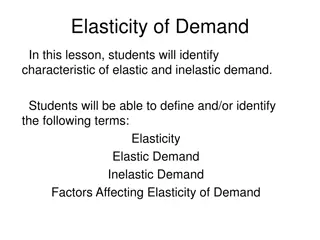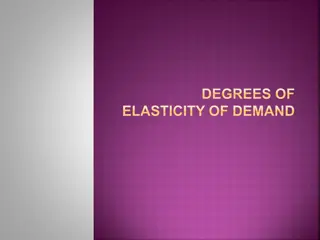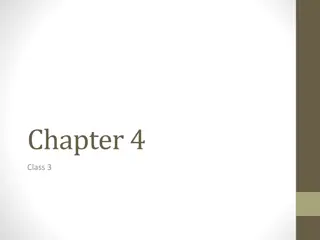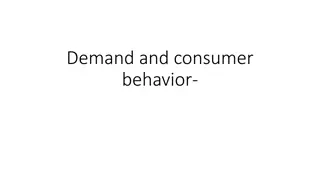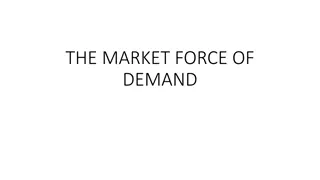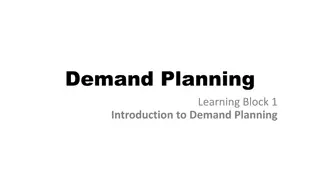Contemporary Approaches to Demand Planning and Management
Relatively recent developments in supply chain processes aim to enhance demand planning and management. Collaborative Planning, Forecasting, and Replenishment (CPFR) facilitate closer supplier-customer coordination to optimize forecasts, production, and orders. Understanding CPFR, pull versus push systems, demand sensing, and demand shaping are crucial for implementing best practices in demand planning.
Download Presentation

Please find below an Image/Link to download the presentation.
The content on the website is provided AS IS for your information and personal use only. It may not be sold, licensed, or shared on other websites without obtaining consent from the author.If you encounter any issues during the download, it is possible that the publisher has removed the file from their server.
You are allowed to download the files provided on this website for personal or commercial use, subject to the condition that they are used lawfully. All files are the property of their respective owners.
The content on the website is provided AS IS for your information and personal use only. It may not be sold, licensed, or shared on other websites without obtaining consent from the author.
E N D
Presentation Transcript
Demand Planning Demand Planning Learning Block 6 Contemporary Approaches to Demand Planning and Management
Course Agenda Course Agenda 1. Introduction to Demand Planning 2. Interaction between Demand Management and Order Management 3. Demand Planning Principles 4. Demand Planning Tools and Techniques 5. Communicating and Managing Demand 6. Contemporary Approaches to Demand Planning and Management 2
Contemporary Approaches to Contemporary Approaches to Demand Planning and Demand Planning and Management Management Learning Block 1
Learning Block Agenda Learning Block Agenda Unit 1: Collaborative Planning, Forecasting, and Replenishment (CPFR) Unit 2: Pull Systems and Push Systems Unit 3: Sensing Demand and Shaping Demand
Description Description Relatively recent developments have been made in supply chain processes to improve demand planning and management. One of these developments is CPFR, a system for helping suppliers and customers work together to increase service and reduce costs. In addition to CPFR, demand shaping and the difference between pull systems and push systems will be reviewed. Demand shaping is a concept in which companies try to influence what customers purchase. Lastly, some key best practices in demand planning will be outlined. 5
Learning Objectives Learning Objectives Understand CPFR, its operation, and its benefits Compare pull systems versus push systems Describe the key aspects of demand sensing Explain the concept of demand shaping Apply some key best practices in demand planning
Unit 1: Collaborative Planning, Forecasting, and Unit 1: Collaborative Planning, Forecasting, and Replenishment Replenishment (CPFR (CPFR) WHAT IS CPFR? CPFR is a method of cooperation between suppliers and customers to align forecasts, production, and orders more accurately so as to reduce the amount of inventory.
OBJECTIVE OF CPFR Increasing product availability to customers while reducing inventory, transportation, and logistics costs It helps reduce the bullwhip effect
THE BULLWHIP EFFECT When businesses are situated further back in the supply chain, inventory swings occur in larger waves in response to customer demand, so that the largest impact of the whip hits suppliers of raw materials, who feel the greatest demand variation in response to customer demand variation. The result is that supply chain participants build and maintain buffer or safety stocks to compensate for swings in orders.
CONTRIBUTORS TO THE BULLWHIP EFFECT Inconsistent Demand Information Lack of Disorganization Communication Lack of Trust Among Supply Chain Partners Inaccurate Lead Times
HOW CPFR WORKS AND PRODUCES RESULTS According to the Voluntary Inter-industry Commerce Standards (VICS), the benefits of implementing CPFR include: Increased sales by 10% to 30% by having product in stock more often Increased margin rate by 2% to 6% by reducing inventory costs Increased in-stock percentages by 2% to 7% from better stock planning Decreased inventory by 10% to 30% by lowering safety stock levels Improved forecast accuracy by 20% to 30% from sharing data Decreased logistics and operating costs by 10% to 28% from all of the above
Unit 2: Pull Systems and Push Systems Unit 2: Pull Systems and Push Systems
PULL SYSTEM vs PUSH SYSTEM Ability to respond quickly to sudden or abrupt changes in demand Pull systems sometimes involve only one-way communication between point of need and point of supply Fast food restaurants operate on pull systems. They make hamburgers and sandwiches in response to current demand because individual purchases trigger more food item production. Meets system-wide inventory needs in an orderly and disciplined way based on a master production plan Push systems involve more two-way communication between point of need and point of supply. Bakery services operate on push systems. They attempt to anticipate what customers will need and push food items to where customers need them ahead of time.
Unit 3: Sensing Demand and Shaping Demand Unit 3: Sensing Demand and Shaping Demand SHAPING DEMAND SENSING DEMAND
SENSING DEMAND Demand sensing is a tactic used to prepare the demand forecast; it involves the collection of information about real-time changes in demand. Monitor changes in markets and consumer buying behavior Analyze current data from the supply chain To create an accurate forecast
SHAPING DEMAND Demand shaping involves influencing customer orders while also reducing the uncertainty of when those orders will occur. Influencing customers with price discounts or other promotional incentives Reducing the uncertainty of when those orders will occur Sales and Marketing Affected by market and economies change Understand customers needs and wants
DEMAND PLAN IMPACT FROM SHAPING AND SENSING Shaping and sensing demand activities must be communicated with Demand Planners and all other relevant groups within a company Demand Planners to update the demand plan, work with key partners inside the firm, ensure the demand plan is met, and confirm that all tasks are being undertaken by the appropriate groups in line with the demand plan.
PRACTICE QUESTIONS 1. CPFR is: a) Also known as demand shaping b) A way of supplying products as they are needed c) A proactive method of sharing information among key supply chain partners d) A formula used to calculate safety stock 2. CPFR is defined as: a) Collaborative forecasting, which involves collecting and reconciling information from inside and outside an organization to come up with a single demand projection b) Non-collaborative forecasting, which involves collecting and reconciling information within an organization to come up with a single demand projection c) Collaborative forecasting, which involves collecting and reconciling information from inside and outside an organization to come up with multiple demand projections d) Collaborative forecasting, which involves collecting and reconciling funds from inside and outside an organization to come up with a single demand projection
PRACTICE QUESTIONS 3. With Collaborative Planning, Forecasting, and Replenishing, supply chain partners coordinate plans in order to: a) Increase variance between supply and demand and share the benefits of a more efficient and effective supply chain b) Reduce variance between supply and demand and share the benefits of a more efficient and effective supply chain c) Increase variance between supply and demand and share the costs of a less efficient and effective supply chain d) Reduce variance between supply and demand and share the benefits of a less efficient and effective supply chain 4. Several factors are critical to the success of, Collaborative Planning, Forecasting, and Replenishing including: a) Excluding supplier inputs b) Ignoring variability c) Disallowing incentives d) Sharing sales information
PRACTICE QUESTIONS 5. A key principle of demand shaping is: a) Encouraging customers to buy alternative products or delay purchasing b) Encouraging customers to buy a competitor s products or to delay purchasing c) Discouraging customers from buying alternative products or delaying purchasing d)Encouraging suppliers to buy alternative products or to delay purchasing 6. When a company has a fixed capacity and demand exceeds supply, the company may: a) Encourage customers to check availability at competing firms b) Do nothing to change demand c) Decrease prices and increase marketing spending d) Encourage customers to buy alternative products of which there may be a greater supply available
PRACTICE QUESTIONS 7. Another tactic used to increase demand is to: a) Offer price discounts b) Increase prices c) Reduce the number of suppliers d) Do nothing 8. One issue with the type of demand shaping described in Question 7 is that, if used on a regular basis: a) Sales will plummet b) Demands will be more difficult to forecast c) Customers may delay purchasing goods until prices are increased d) Buying behaviors may change
PRACTICE QUESTIONS 9. Sometimes called a reactive system, the pull approach relies on: a) Customer demand to pull a product through the logistics system b) Supplier demand to pull a product through the logistics system c) Top management demands to pull a product through the logistics system d) Customer demands for reduced prices 10. Management and prioritization, or reprioritization, of demand should occur when it becomes evident that: a) All other actions have failed b) The company has become insolvent c) Demand is steady d) The volume, mix, and timing of actual demand differs from the demand plan
